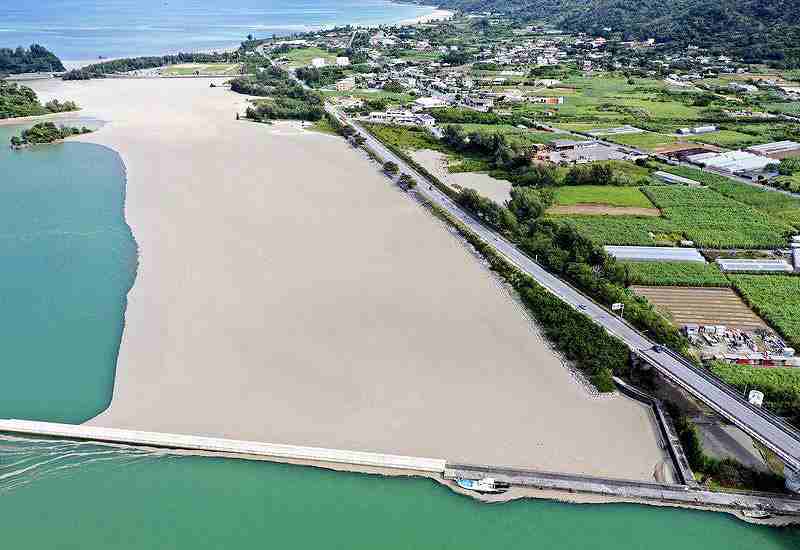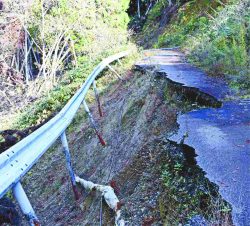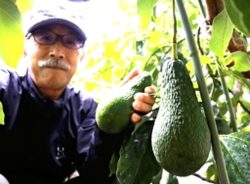
A massive amount of pumice covers the sea on the coast of Nago, Okinawa Prefecture, on Nov. 10.
November 15, 2021
A massive amount of pumice ejected from the undersea volcano Fukutokuokanobaba near the Ogasawara Islands has been washing ashore in Okinawa and Kagoshima prefectures, negatively affecting fishing, tourism and other industries.
The stones have proven difficult to remove, with the central government yet to provide specific assistance. The pumice is expected to approach Honshu possibly by later this month, where it could have an even greater impact.
Okinawa suffers
Mozuku seaweed is cultivated at the Hama fishing port in Uruma, Okinawa Prefecture. Pumice started washing ashore there in mid-October, forming a layer several centimeters thick on top of the sea. Aquaculture workers and others have tried to scoop the stones up with nets and shovels, but the tides and winds keep bringing more from farther out to sea. They clog the water intake lines of fishing boats and damage their engines, which has kept boats in port.
Okinawa is the source of more than 90% of the mozuku produced nationwide. It is currently the season when seeded aquaculture nets are transported by ship and submerged in the sea.
“If nothing is done, our production could drop sharply,” said Naoto Uemura, 45, who runs an aquaculture business.
The Fisheries Agency has indicated it will use the fishery insurance system to help cover income losses by fishermen and repair boats.
The tourism industry has also been hit.
Onna, Okinawa Prefecture, is home to several resort hotels. Local marine recreation companies have seen numerous cancellations. A state of emergency for the novel coronavirus was only recently lifted on Oct. 1 after being in place for about four months.
Seiichi Harada, 52, who runs a company in Onna, lamented, “Infections had dropped and things were just starting to look brighter.”
According to the Japan Tourism Agency, tourism businesses that are affected by natural disasters are covered by the Disaster Relief Law, though an official in charge said: “It’s difficult to fit pumice within the existing framework. We’re discussing how to provide aid with the prefectural government.”
Some construction work for relocating the U.S. Marine Corps’ Futenma Air Station from Ginowan to the Henoko district of Nago in the prefecture has also been suspended.
Concerned about how the pumice will impact coral reefs and other ecosystems, the prefecture has asked the central government to investigate.
Winds, tides
A massive amount of pumice that was ejected in the eruption in August was able to move about 1,300 kilometers to wash ashore around Okinawa because it was so much larger than past ones. The National Institute of Advanced Industrial Science and Technology said it was the largest eruption in Japan since World War II. At least 100 million cubic meters of pumice and other material is estimated to have been ejected in the eruption, or enough to fill Tokyo Dome about 80 times.
The central government said pumice had washed ashore at 100 ports in Okinawa and Kagoshima prefectures as of Nov. 11. The stones have been removed or caused little damage in 71 ports, removal work is ongoing at 13 ports, and 16 ports are preparing to begin work.
In Okinawa Prefecture, pumice has been removed via heavy machinery at the Ada and Hentona fishing ports in Kunigami, where accumulations were particularly large.
Fencing
One issue is how to dispose of the pumice. An analysis of some pumice from Okinawa found that levels of lead and other substances were within environmental quality standards for soil, and thus it could be used as material for agriculture or other purposes.
Pressure to prepare a response is rising in areas of Honshu where pumice is likely to wash ashore.
Takeshi Sugiyama, 61, is chairman of an association of fishermen who bring in the famous Shonan shirasu (whitebait) in Sagami Bay in Kanagawa Prefecture.
“The tender shirasu will be damaged if pumice gets into the nets. It won’t be suitable for market. If pumice gets into the fishing port, our boats may not be able to leave,” he said.
With the possibility of pumice arriving on Honshu, the Land, Infrastructure, Transport and Tourism Industry is planning to inform local governments about effective countermeasures by the end of this month. If pumice washes up, it could be kept out of ports using fences, but this also keeps boats from entering and leaving. Ministry officials worry it may be difficult to put up a fence until right before the pumice arrives.
Tokai, Kanto this month?
By Shinichiro Matsuda / Yomiuri Shimbun Staff Writer
Large amounts of pumice are expected to reach the Tokai and Kanto regions in late November. If this occurs, the effect on the fishing industry could be serious, but where and how much pumice is washed ashore depends greatly on local tides and winds, making accurate predictions difficult.
Toru Miyama, senior researcher of physical oceanography at the Japan Agency for Marine-Earth Science and Technology, simulated the movement of the pumice expelled from Fukutokuokanoba using a supercomputer.
He determined it would ride the Kuroshio Current from around Okinawa to eastern Japan. The Kuroshio Current meanders south of the Kii Peninsula, which for a time could take the pumice away from Honshu.
The “vanguard” of the pumice stones on the Kuroshio Current is believed to be currently in this area. It is expected to move northward and approach the coasts of Shizuoka, Chiba and other prefectures in late November.
However, this forecast is based on large ocean current movements and does not reflect the effects of small coastal currents or winds.
On the main Okinawa island, some pumice floated around from the east to reach the west shore on the opposite side. There were also reports of pumice disappearing from fishing ports overnight only to reappear a few days later.
Takeyoshi Nagai, associate professor of physical oceanography at Tokyo University of Marine Science and Technology, said, “The ebb and flow of the tides and the effects of wind are larger close to land, which makes movements unpredictable.”
Pumice stones are brittle and full of tiny holes, and get ground down when they rub against each other.
Yuzo Kato, professor emeritus of petrology at the University of the Ryukyus, said, “If they become too small to be supported by buoyancy, they’ll sink, but it will take several years for most of them to disappear.”
According to the Japan Meteorological Agency, Japan has 111 active volcanoes on land and sea. Large eruptions of pumice have been a problem in the past from volcanoes near the sea such as Sakurajima in Kagoshima Prefecture and submarine volcanoes such as Fukutokuokanoba.
In a highly volcanic country like Japan, another such situation could occur in the future if the size of the eruption and the ocean currents align.
"Society" POPULAR ARTICLE
-

M4.9 Earthquake Hits Tokyo, Neighboring Prefectures
-

Israeli Tourists Refused Accommodation at Hotel in Japan’s Nagano Pref., Prompting Protest by Israeli Embassy and Probe by Prefecture
-

M7.5 Earthquake Hits Northern Japan; Tsunami Waves Observed in Hokkaido, Aomori and Iwate Prefectures
-

Tsukiji Market Urges Tourists to Avoid Visiting in Year-End
-

M5.7 Earthquake Hits Japan’s Kumamoto Pref., Measuring Upper 5 Intensity, No Tsunami Expected
JN ACCESS RANKING
-

Keidanren Chairman Yoshinobu Tsutsui Visits Kashiwazaki-Kariwa Nuclear Power Plant; Inspects New Emergency Safety System
-

Tokyo Economic Security Forum to Hold Inaugural Meeting Amid Tense Global Environment
-

Imports of Rare Earths from China Facing Delays, May Be Caused by Deterioration of Japan-China Relations
-

University of Tokyo Professor Discusses Japanese Economic Security in Interview Ahead of Forum
-

Japan Pulls out of Vietnam Nuclear Project, Complicating Hanoi’s Power Plans
























